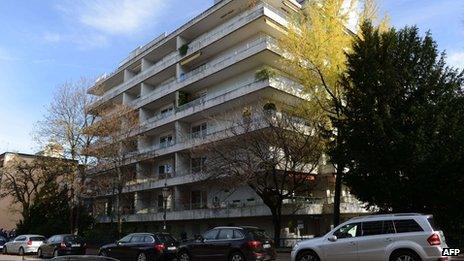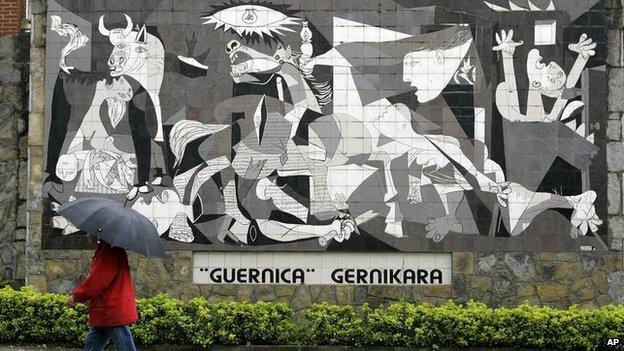Nazi loot case: Much art still untraced - expert
- Published

Hundreds of precious artworks were found in this plain Munich apartment block
A British expert on art looted by the Nazis says the hoard of 1,500 artworks found in Munich is just "the tip of the iceberg" as many owners are still trying to recover their property.
The Munich trove is believed to include works by Matisse, Picasso and Chagall.
The total value is estimated at about one billion euros (£846m; $1.35bn).
Anne Webber of the Commission for Looted Art in Europe said about 90% of works sought by their owners are still untraced.
In Western Europe during the war the Nazis often used devalued currency to acquire important artworks cheaply in occupied countries, though in Eastern Europe they carried out large-scale looting.
The Munich works are thought to be among the many which the Nazis either seized from Jews or removed from galleries as "degenerate" modern art.
The German magazine Focus said the artworks were found by chance when the tax authorities investigated Cornelius Gurlitt, the reclusive son of an art dealer in Munich.
He was suspected of tax evasion, and investigators obtained a search warrant for his apartment in Munich in early 2011.
There, they found the cache of some 1,500 artworks which had vanished from sight during the Nazi era.
Art historian Godfrey Barker spoke to the BBC about the significance of this discovery
The younger Mr Gurlitt had kept the works in darkened rooms, surrounded by clutter, and sold the occasional painting when he needed money, Focus reports.
They have been kept in a secure wing of Bavarian customs while experts try to find out who they belonged to, the magazine says.
The Bavarian customs authorities and prosecutors will give a news conference about the discovery at 10:00 (09:00 GMT) on Tuesday, at the state prosecutor's office in Augsburg, a customs official told the BBC.
Dealers' network
Speaking to BBC News, Ms Webber said the Bavarian authorities must publish a list of the works that have been found, "and say when they are going to publish it and enable the return of any looted works to their rightful owners".
Ms Webber runs a registry of missing artworks,, external some of which were held in Nazi collections during 1933-1945.
Many of the Nazi-era dealers were able to keep some looted paintings for themselves and after the war they carried on working as art dealers, she told the BBC. There was a network of dealers in Bavaria who were able to dispose of paintings over the ensuing decades and to launder art that had been in the collections of former Nazis, she explained.
There are international warrants out for at least 200 of the Munich works, Focus reports.
'Degenerate art'
In 1937, the Nazis staged an exhibition to ridicule modern art - it went on to be one of the best attended modern art exhibitions of all time.
One of the pieces is said to be a portrait of a woman by Matisse which belonged to the grandfather of French TV presenter Anne Sinclair.
Paul Rosenberg, an art dealer who represented Picasso as well as Matisse, was forced to leave his collection behind when he fled France in 1940.
According to the Jewish Claims Conference, the Nazis seized an estimated 650,000 artworks and religious items from Jews and other victims.
Correction 5 November 2013: Anne Webber's comments to the BBC were initially misconstrued and were amended, after clarification from her. The headline was also changed. Her key point is that most of the works still sought by their owners are untraced - not just works that were looted by the Nazis.

The Nazis detested Picasso, whose artwork Guernica depicted a German bombing during the Spanish Civil War
- Published3 November 2013
- Published29 October 2013
- Published4 November 2013
- Published22 June 2013
- Published5 May 2011